Micro-Displacement and Storage Mechanism of CO2 in Tight Sandstone Reservoirs Based on CT Scanning
Abstract
:1. Introduction
2. Core Flooding Experiment
2.1. Experimental Setup
2.2. Experimental Core and Fluid
2.3. Experimental Steps
- (1)
- Imaging of the dry core
- (2)
- CT scanning procedure
- (3)
- Fluid distribution under the condition of irreducible water (initial oil saturation)
- (4)
- During the test, the specific temperature and pressure were set, the CO2 core displacement experiment was performed, the core holder was transferred to the CT scanning experimental device, and the CT scanning experiment was carried out.
- (5)
- During the CT scanning, the data of several time points were recorded, including the original saturated oil, the completion of CO2 flooding, and the completion of the subsequent water flooding, and the change of the formation liquid saturation was analyzed. Then, the distribution and burial rate of CO2 in the rock core were inversely calculated;
- (6)
- The above steps were repeated to carry out the core displacement and CT scanning experiments for the different cores.
3. CT Scanning Core Experiment
4. Core Flooding Experiment
4.1. CO2 Flooding
4.2. CO2 Flooding → Water Flooding
4.3. Firstst Water Flooding → CO2 Flooding → 2nd Water Flooding
4.4. Saturated Crude Oil →1st Water Flooding → CO2 Flooding → 2nd Water Flooding
4.5. Discussion of Flooding of the Cores
5. Conclusions
Author Contributions
Funding
Institutional Review Board Statement
Informed Consent Statement
Data Availability Statement
Conflicts of Interest
References
- Hu, W.; Lv, C.; Wang, R.; Yang, Y.; Wang, X. Mechanism of CO2 immiscible flooding and distribution of remaining oil in water drive oil reservoir. Pet. Geol. Recovery Effic. 2017, 24, 99–105. [Google Scholar] [CrossRef]
- Li, K.; Li, P.; Wei, M.; Qiang, X.; Li, X. A pilot project of CO2 enhanced oil recovery and storage in Chang 8 extra-low permeability reservoir in Huang 3 district of Changqing oilfield. J. Eng. Geol. 2021, 29, 1488–1496. [Google Scholar] [CrossRef]
- Gao, J.; Han, D.; Wang, J.-L.; Wu, K.-Y.; Liu, L. Application of CT scanning image technique to study of oil saturation distribution in core displacement test. Xinjiang Pet. Geol. 2009, 30, 269–271. [Google Scholar]
- Guo, Y.; Ou, Y.C.X. Experimental study on improving oil displacement efficiency of low-permeability core with CT scan. China Sci. Pap. 2020, 15, 476–480. [Google Scholar]
- Li, J.; Jiang, H.; Wang, C.; Zhao, Y.; Gao, Y.; Pei, Y.; Wang, C.; Dong, H. Pore-scale investigation of microscopic remaining oil variation characteristics in water-wet sandstone using CT scanning. J. Nat. Gas Sci. Eng. 2017, 48, 36–45. [Google Scholar] [CrossRef]
- Liu, Y.; Wang, C.S.; Sun, Q.J. Digital core construction and seepage simulation of low permeability sandstone reservoir. Fault-Block Oil Gas Field 2017, 24, 817–821. [Google Scholar] [CrossRef]
- Deng, S.; Lv, W.; Liu, Q.; Leng, Z.; Tong, T.L. Research on displacement mechanism in conglomerate using CT scanning method. Pet. Explor. Dev. 2014, 41, 330–335. [Google Scholar] [CrossRef]
- Hou, J.; Luo, F.; Li, Z.; Bing, S.; Zhang, Y.; Li, J. The critical description scale study on core microscopic and reservoir macroscopic remaining oil. Pet. Geol. Recovery Effic. 2014, 21, 95–99. [Google Scholar] [CrossRef]
- An, S.; Yao, J.; Yang, Y.; Zhang, W.; Zhao, J.; Li, A. The microscale analysis of reverse displacement based on digital core. J. Nat. Gas. Sci. Eng. 2017, 48, 138–144. [Google Scholar] [CrossRef]
- Guo, C.; Wang, X.; Wang, H.; He, S.; Liu, H.; Zhu, P. Effect of pore structure on displacement efficiency and oil-cluster morphology by using micro computed tomography (μCT) technique. Fuel 2018, 230, 430–439. [Google Scholar] [CrossRef]
- Li, J.; Jiang, H.; Zhou, D.; Yang, Z.; Chen, W. Experimental study on the microscopic displacement mechanism of remaining oil by low salinity water flooding in the paleo-oil reservoir. Pet. Geol. Recovery Effic. 2018, 25, 104–109. [Google Scholar] [CrossRef]
- Li, J.; Cheng, B.; Liu, R.; Meng, F.; Liu, Y.; Gao, Y.; Ma, K.; Jiang, H. Microcosmic mechanism of water sensitivity in pore-scale conglomerate based on digital core. Acta Pet. Sin. 2019, 40, 594–603. [Google Scholar]
- Han, J.; Han, S.; Kang, D.H.; Kim, Y.; Lee, J.; Lee, Y. Application of digital rock physics using X-ray CT for study on alteration of macropore properties by CO2 EOR in a carbonate oil reservoir. J. Pet. Sci. Eng. 2020, 189, 1–12. [Google Scholar] [CrossRef]
- Yang, Y.; Cai, S.; Yao, J.; Zhong, J.; Zhang, K.; Song, W.; Zhang, L.; Sun, H.; Lisitsa, V. Pore-scale simulation of remaining oil distribution in 3D porous media affected by wettability and capillarity based on Volume of Fluid method. Int. J. Multiph. Flow. 2021, 143, 1–14. [Google Scholar] [CrossRef]
- Wang, Z.; Zhao, H.; Zhu, G. Storage characteristics of residual oil in water drive of porous bioclastic limestone reservoir. Fault-Block Oil Gas Field 2021, 28, 392–396. [Google Scholar] [CrossRef]
- Adebayo, A.R.; Kandil, M.E.; Okasha, T.M.; Sanni, M.L. Measurements of electrical resistivity, NMR pore size and distribution, and x-ray CT-scan for performance evaluation of CO2 injection in carbonate rocks: A pilot study. Int. J. Greenh. Gas Control 2017, 63, 1–11. [Google Scholar] [CrossRef]
- Gunde, A.C.; Bera, B.; Mitra, S.K. Investigation of water and CO2 (carbon dioxide) flooding using micro-CT (micro-computed tomography) images of Berea sandstone core using finite element simulations. Energy 2010, 35, 5209–5216. [Google Scholar] [CrossRef]
- Saraf, S.; Bera, A. A Review on pore-scale modeling and CT scan technique to characterize the trapped carbon dioxide in impermeable reservoir rocks during sequestration. Renew. Sustain. Energy Rev. 2021, 144, 110986. [Google Scholar] [CrossRef]
- Cao, Y.N. Study on core micro-displacement process by CT scanning technology. Sci. Technol. Eng. 2015, 15, 64–69. [Google Scholar]
- Yu, Y.; Xu, H.; Gao, X.; Jiang, T.; Fang, H.; Sun, T. Distribution and occurrence of microscopic remaining oil at different scales in Marine clastic reservoir: A case study of Donghe sandstone in Hudson Oilfield. Acta Pet. Sin. 2018, 39, 1397–1409. [Google Scholar] [CrossRef]
- Tang, J.; Vincent-Bonnieu, S.; Rossen, W.R. CT coreflood study of foam flow for enhanced oil recovery: The effect of oil type and saturation. Energy 2019, 188, 1–11. [Google Scholar] [CrossRef]
- Xie, M.Y.; Dai, Z.; Luo, D.H. A new method for residual oil characteristics analysis of heavy oil reservoirs based on micron CT scanning displacement experiment. Unconv. Oil Gas 2020, 7, 102–107. [Google Scholar]
- Lv, W.; Leng, Z.; Zhang, Z.; Ma, D.; Liu, Q.; Wu, K.; Li, T. Study on water flooding mechanism of low permeability core using CT scanning technology. Pet. Geol. Recovery Effic. 2013, 20, 87–91. [Google Scholar]
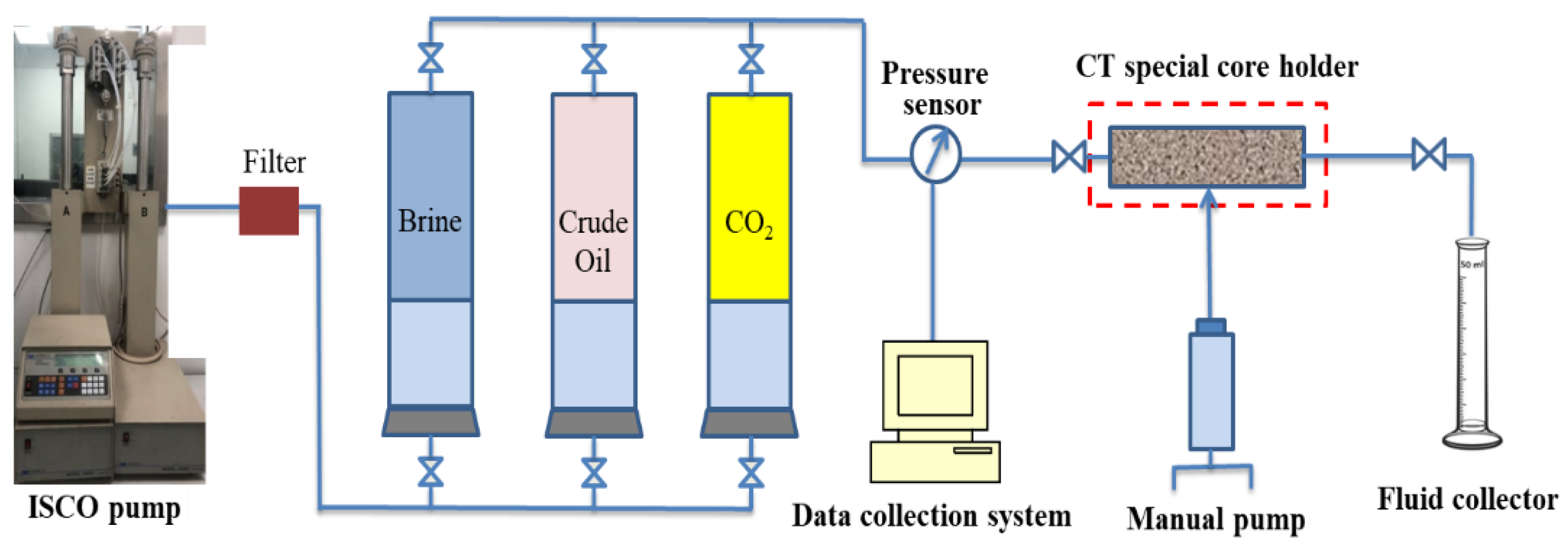

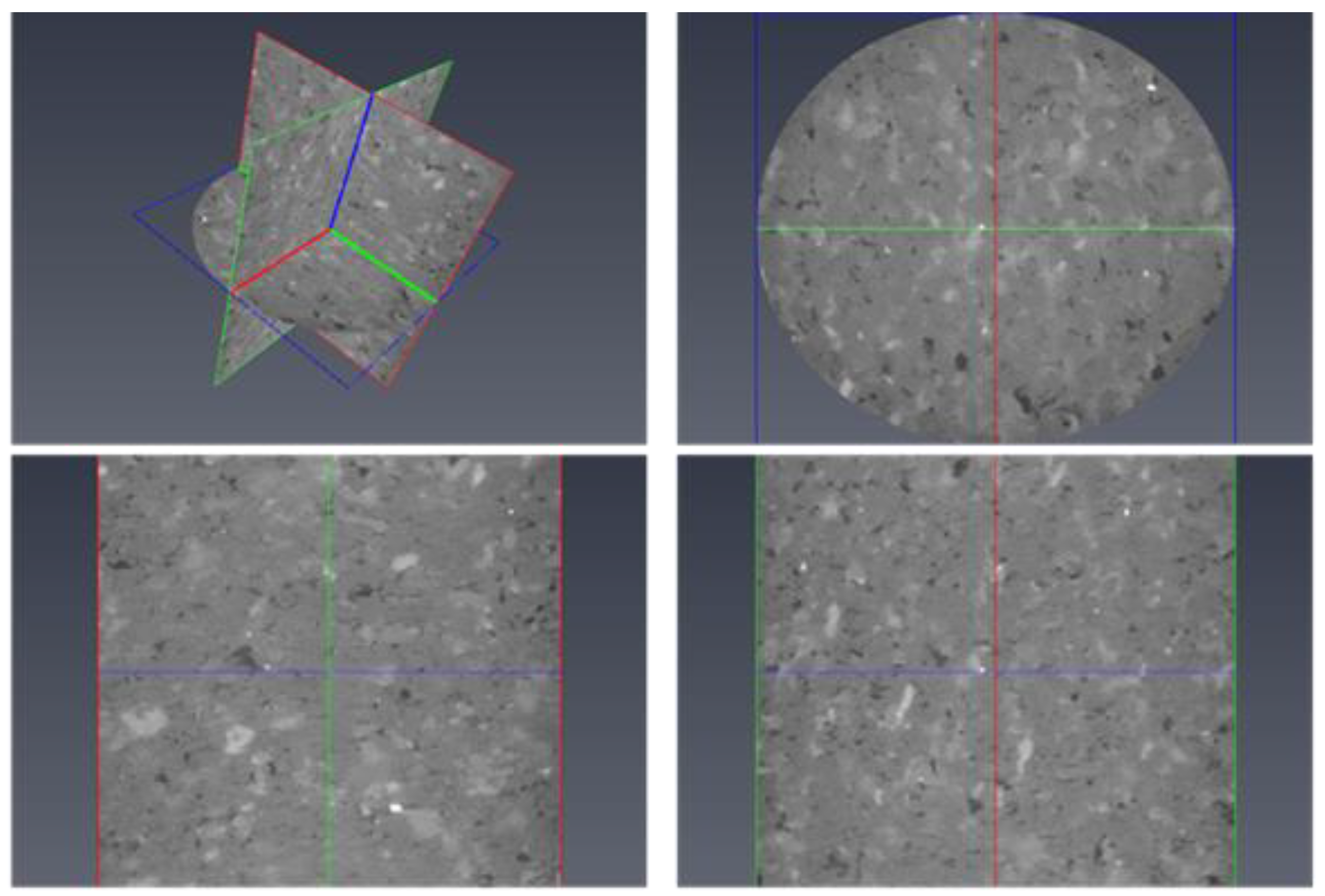
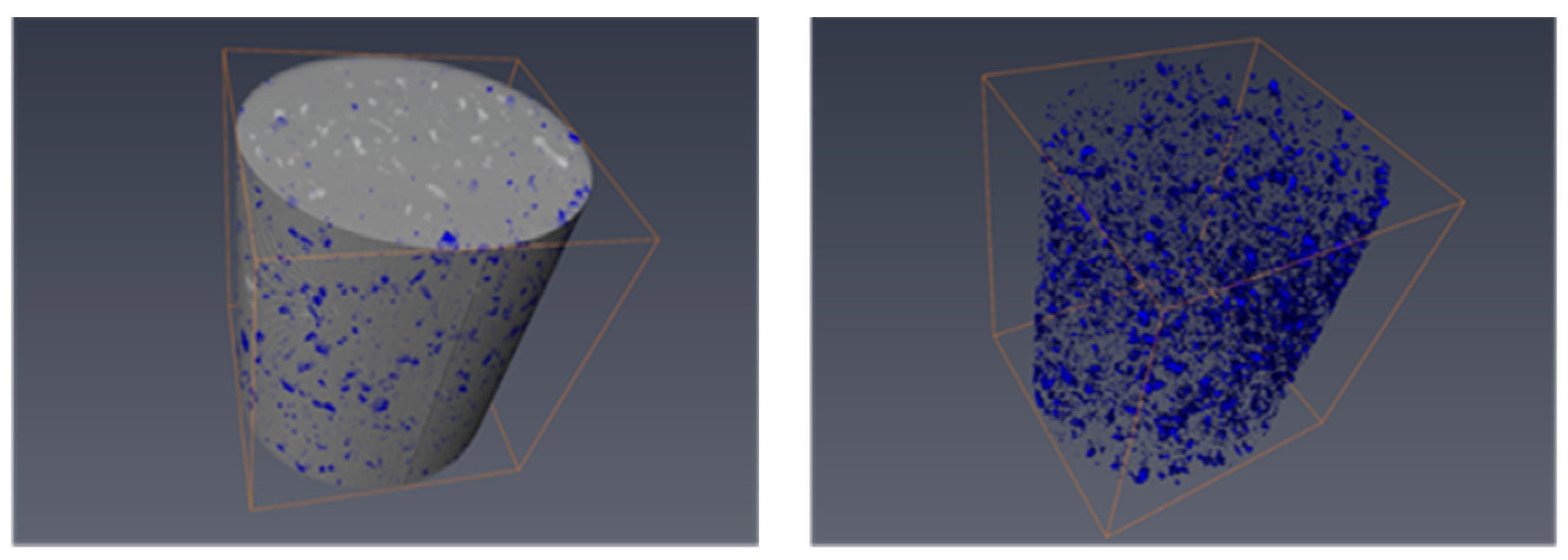


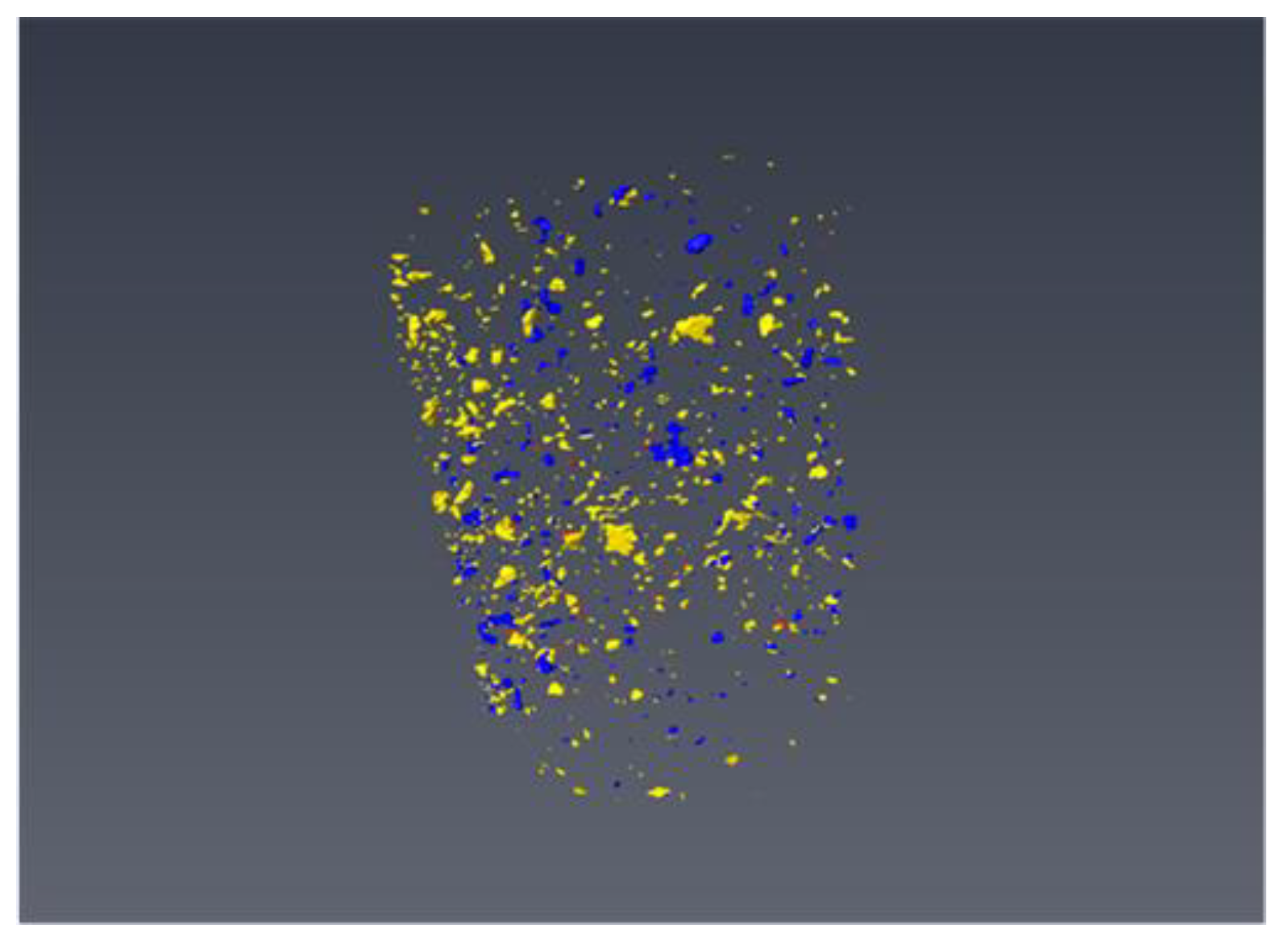


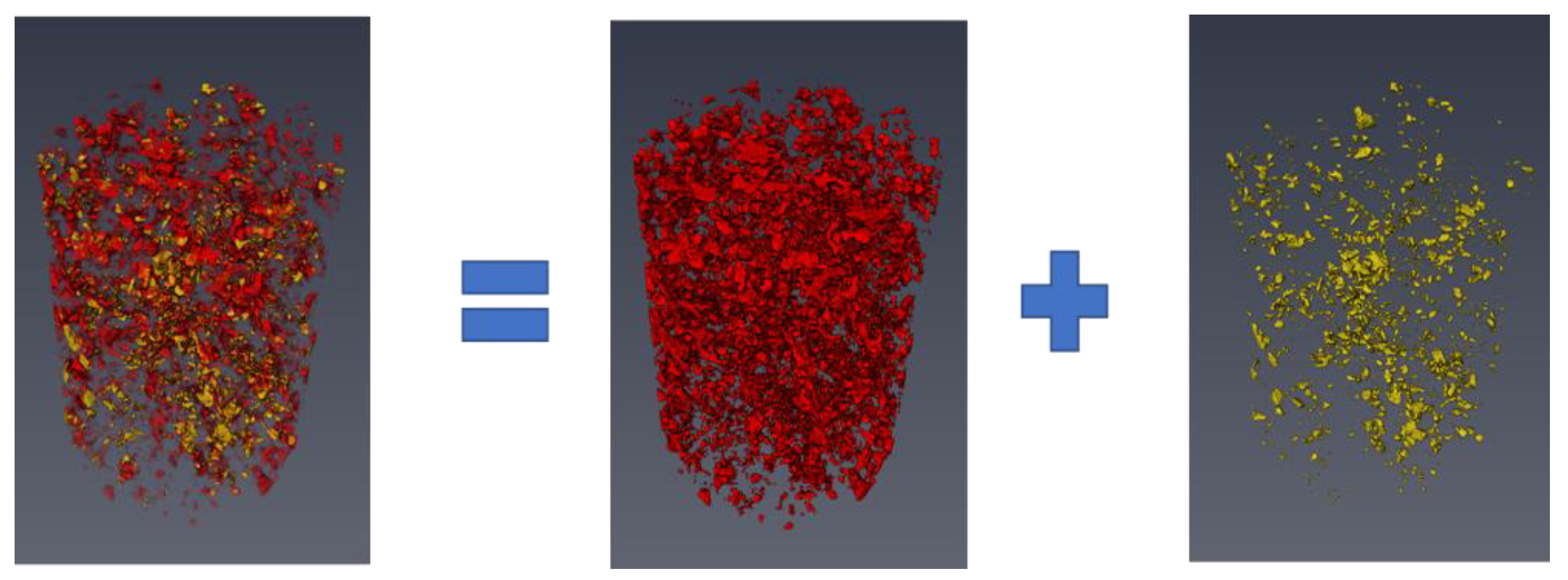











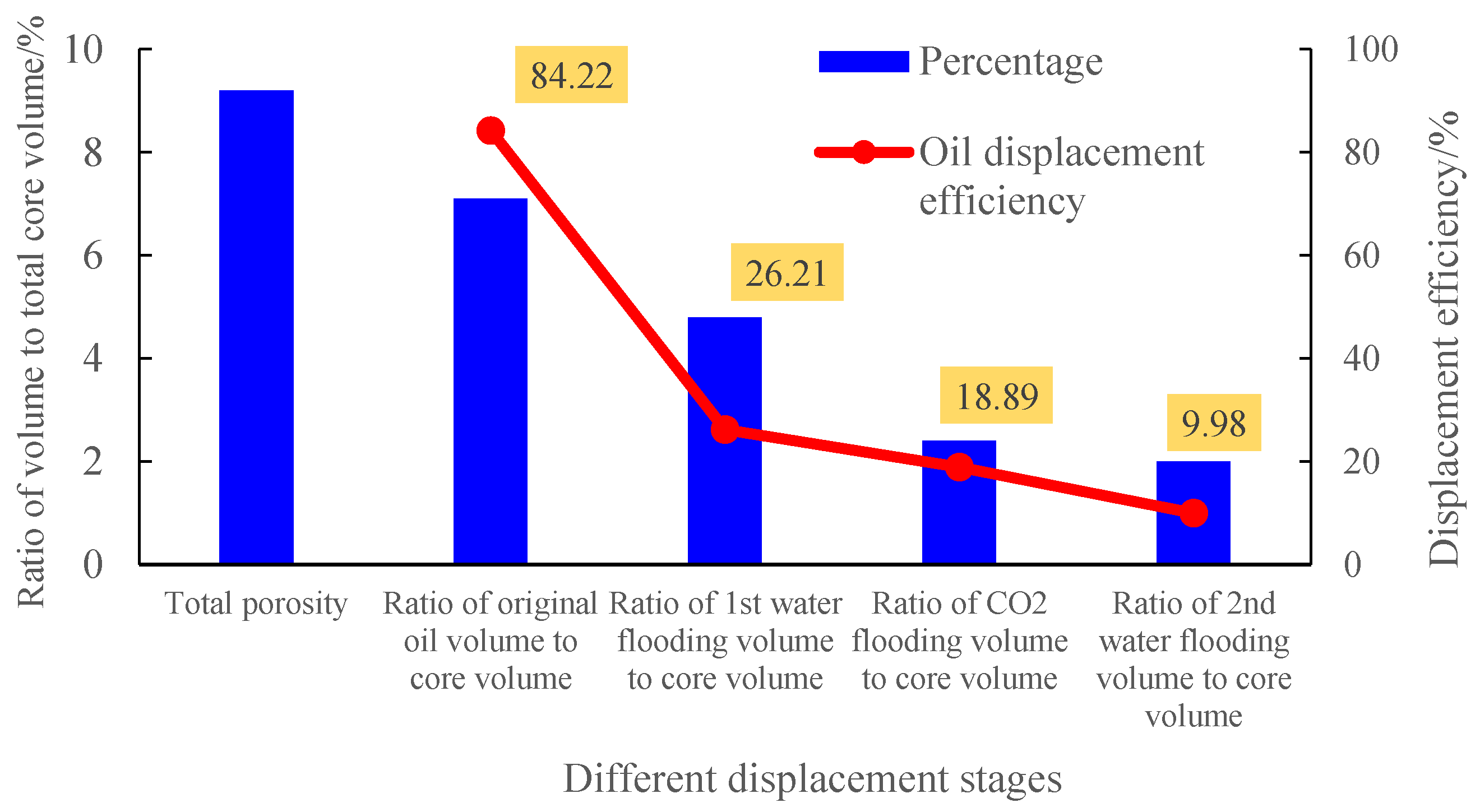
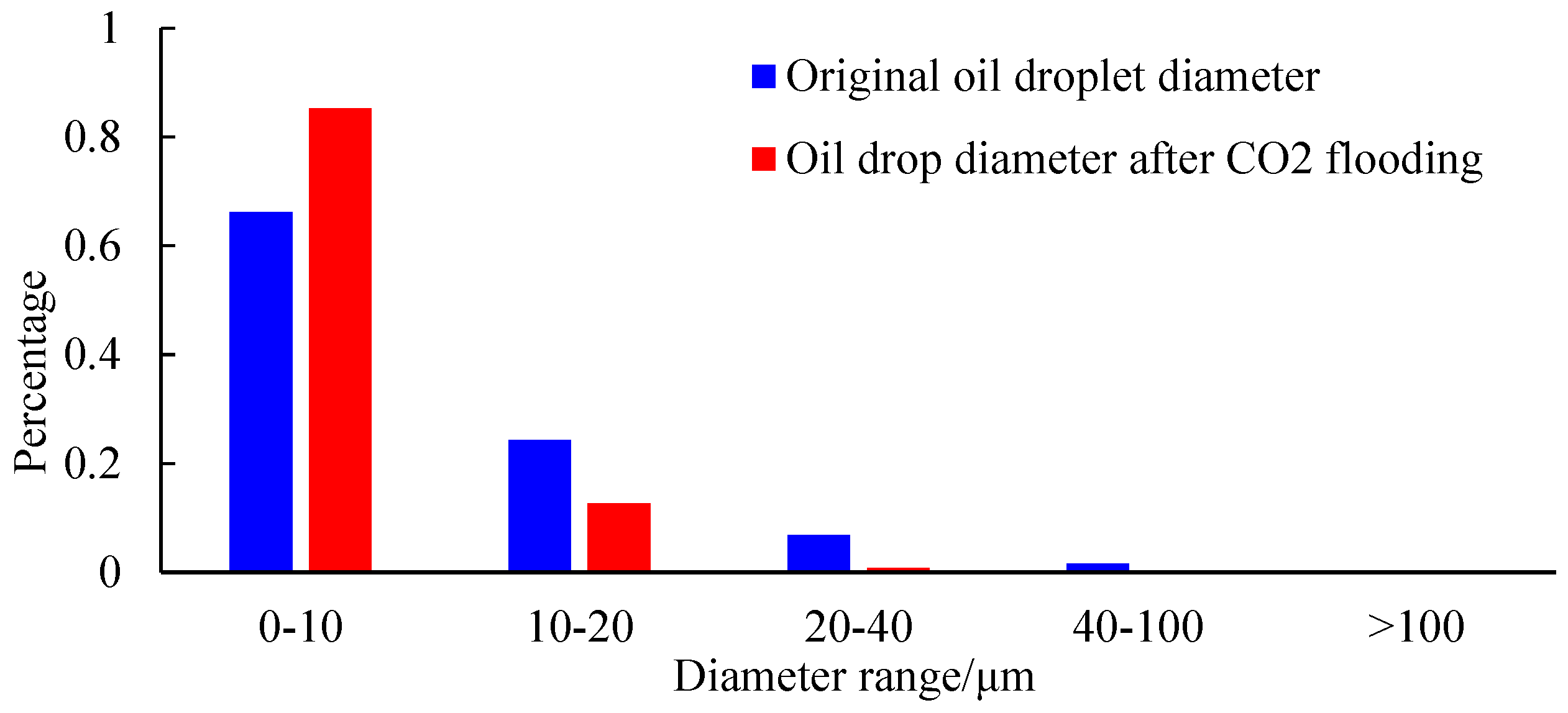
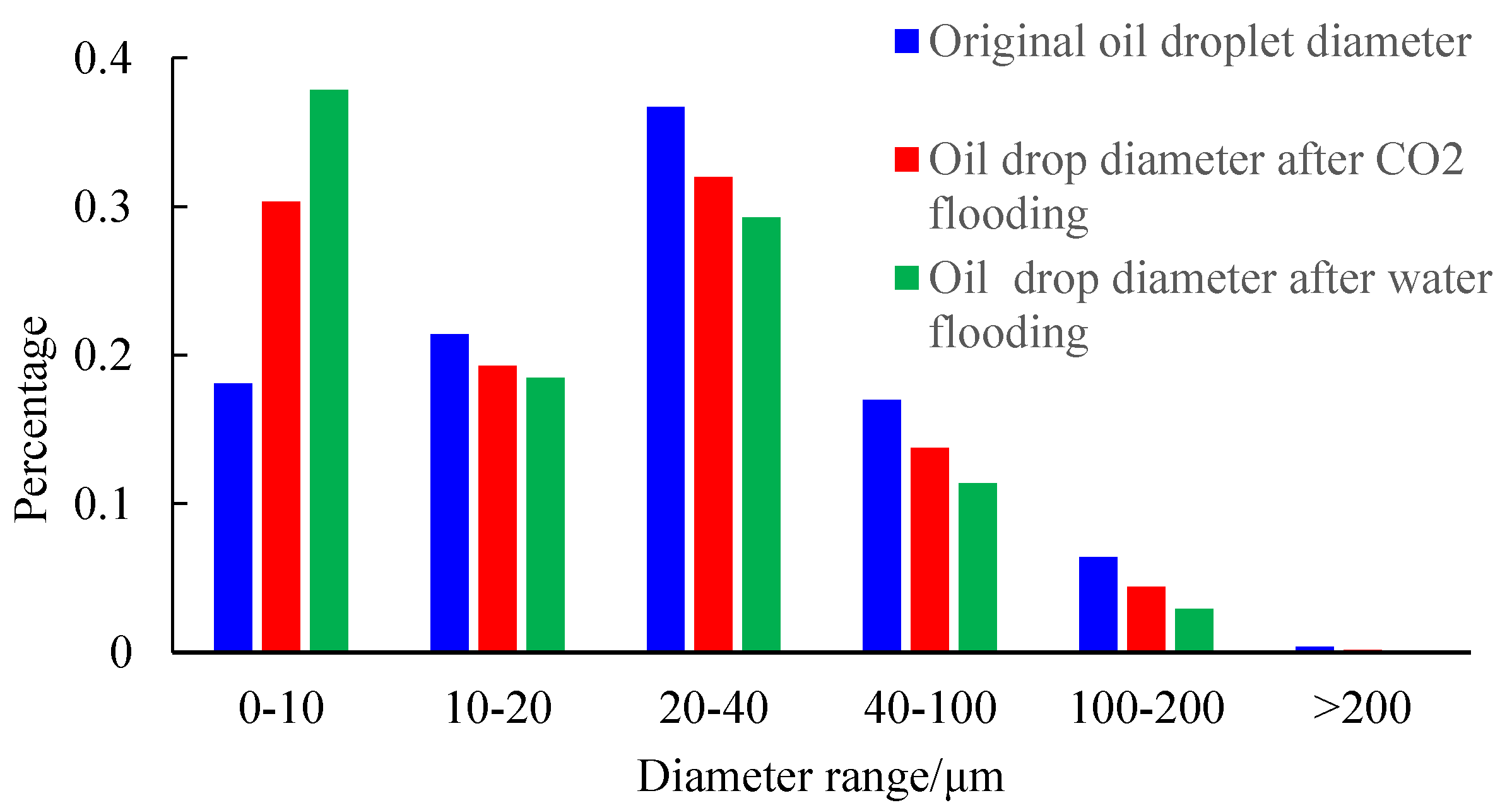


| Well Name | Porosity (%) | Permeability (mD) | Displacement Modes |
|---|---|---|---|
| Y29–100 | 7.74 | 0.16 | Saturated crude oil → CO2 flooding |
| Y40–92 | 10.22 | 0.59 | Saturated crude oil → CO2 flooding → water flooding |
| Y53–89 | 11.58 | 0.97 | Saturated crude oil → 1st water flooding → CO2 flooding → 2nd water flooding |
| Y56–19 | 12.68 | 0.99 | Saturated formation water → saturated crude oil → 1st water flooding → CO2 flooding → 2nd water flooding |
Publisher’s Note: MDPI stays neutral with regard to jurisdictional claims in published maps and institutional affiliations. |
© 2022 by the authors. Licensee MDPI, Basel, Switzerland. This article is an open access article distributed under the terms and conditions of the Creative Commons Attribution (CC BY) license (https://creativecommons.org/licenses/by/4.0/).
Share and Cite
Yue, P.; Liu, F.; Yang, K.; Han, C.; Ren, C.; Zhou, J.; Wang, X.; Fang, Q.; Li, X.; Dou, L. Micro-Displacement and Storage Mechanism of CO2 in Tight Sandstone Reservoirs Based on CT Scanning. Energies 2022, 15, 6201. https://doi.org/10.3390/en15176201
Yue P, Liu F, Yang K, Han C, Ren C, Zhou J, Wang X, Fang Q, Li X, Dou L. Micro-Displacement and Storage Mechanism of CO2 in Tight Sandstone Reservoirs Based on CT Scanning. Energies. 2022; 15(17):6201. https://doi.org/10.3390/en15176201
Chicago/Turabian StyleYue, Ping, Feng Liu, Kai Yang, Chunshuo Han, Chao Ren, Jiangtang Zhou, Xiukun Wang, Quantang Fang, Xinxin Li, and Liangbin Dou. 2022. "Micro-Displacement and Storage Mechanism of CO2 in Tight Sandstone Reservoirs Based on CT Scanning" Energies 15, no. 17: 6201. https://doi.org/10.3390/en15176201






